It is critical for a user to discuss the finer points of their application with a valve supplier to ensure optimal valve performance.
May 2, 2023

Kevin Steele, engineering manager, Rotolok Valves Inc.
When you visit any large-scale production facility you will almost certainly see a rotary valve quietly going about its work, processing the raw materials and finished products used in so much of the goods we consume every day. From food to pharmaceuticals, aggregates to chemicals, animal feed to biomass, rotary valves are an essential part of the majority of processing systems.
Known also as rotary valves, rotary airlocks, and rotary feeders, they are designed to manage and meter the flow of bulk powders, granules, and other dry products from one part of a system to another. Product is fed into the inlet of the valve from silos, bulk bags, conveyors, and other such feed systems, passed through the valve and onto the next part of the system with minimal air loss.
The modern rotary valve is a flexible unit. Not only does it control the feed of product within a system, but it also acts as a process isolator and can even act as an explosion/flame barrier if required, preventing potential significant damage not only to other parts of the process system but also preventing harm to site personnel.
How Does a Rotary Valve Work?
The rotary valve is a simple beast. When broken down to its basic parts it comprises a housing to contain the product and within the housing a rotating paddle, known as a rotor. This rotor is simply a central shaft with paddles or vanes welded to the shaft to create a series of pockets in which the product is conveyed from the inlet to the outlet.
A drive system--normally an electric gearmotor unit--is connected to one end of the shaft and provides rotational movement to the rotor. As the product is introduced to the inlet side of the valve it falls into the pockets of the rotor, the drive turns the rotor conveying to the outlet where it then falls into the next part of the overall processing system. The speed at which the rotor turns dictates the flow of product through the valve.
The Rotor
The rotor is in constant contact with the product being processed and so is subject to movement and associated wear. With gentle products this does not cause any issues and so the rotor should last many years. However, other products and applications provide more of a challenge and so it is vitally important that the right type of rotor is selected to ensure optimal process operational parameters, minimize wear, and prevent potential increased air loss in pressurized systems.
There are many different types of rotor, each suited to differing products and applications.
Open Fixed Rotor
This is probably the most ubiquitous rotor used in many rotary valves. Consisting of a central shaft with plain vanes, the open fixed rotor is suitable for many applications. When machined with suitably tight clearances it offers a high level of sealing with minimal air loss across it. The open fixed rotor is also the most economical rotor to manufacture, and this helps to explain why it is so prevalent.
However, fixed vanes are not best suited for use with abrasive products. Once the vanes start to wear, air loss increases and the whole rotor would need to be replaced.
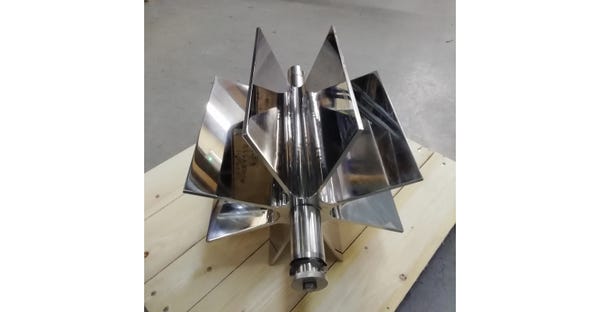
Open Adjustable Rotor
The open adjustable rotor is a variation of the open fixed rotor and includes separate adjustable and replaceable blades bolted to the welded fixed vanes.
These replaceable blades can be manufactured in a range of materials to suit the product being processed. For abrasive products, wear-resistant steel can be specified. If handling delicate or fragile products rubber blades can be used that will ride over any trapped product, minimizing damage to both the product and the valve itself. When solid blades are used, they have a level of adjustment that enables the operator to reset them to compensate for wear and so mitigate air loss. The ability to adjust and replace the blades both maximizes the life of the rotor and reduces replacement costs.
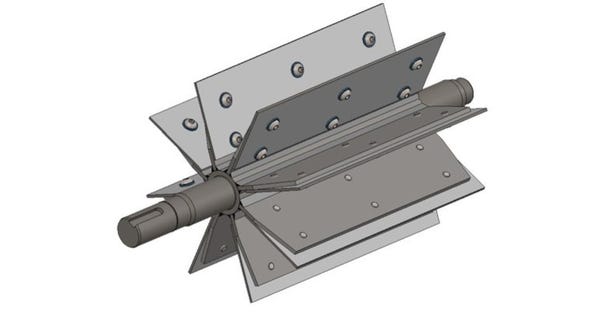
Closed Fixed Rotor
The closed fixed rotor takes the open fixed concept and adds shielding end discs at each end of the rotor. This makes the closed rotor ideal for handling abrasive products as it contains the product within the rotor pocket preventing it rubbing against the cast end plates of the housing and causing wear.
Closed rotors tend to have slightly larger clearances than open rotors and so are better suited to gravity fed low differential pressure applications where high sealing/airlock requirements are not such an issue.
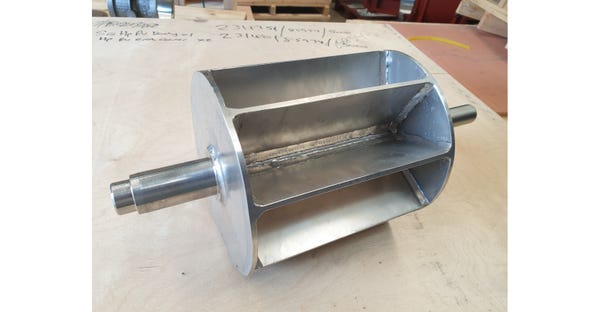
Closed Tipped Rotor
Much like the open adjustable rotor, the closed tipped rotor takes the concept of the closed fixed rotor and adds adjustable/replaceable tips that provide the operator with the facility to compensate for wear. This in turn helps to reduce maintenance costs as only the tips need replacing and not the complete rotor. Again, material choice for the replaceable tips can be specified to best suit the product being processed.
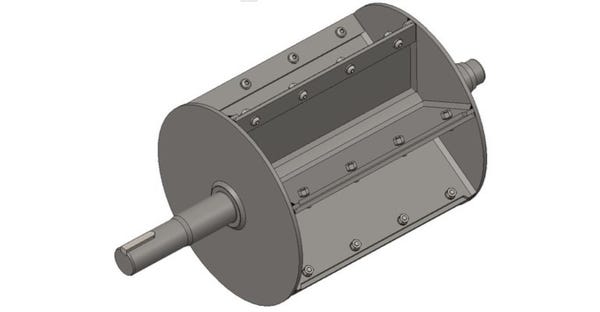
Further Rotor Options
The rotors shown form the backbone of most rotary valves in operation today. However, there are a myriad of special options that can be applied to best suit more specialized applications. These options include:
* Scalloped Rotors: The bottom of each rotor pocket is rounded (scalloped) to remove the natural narrow ‘V’ profile. Designed for use with sticky products, the scalloped profile prevents product packing in the pocket and aids product release from the pocket.
* Open/Closed Rotor: This type of rotor offers the best of both worlds in combining the optimal air sealing capabilities of an open rotor with the wear protection offered by the inclusion of end discs.
* Staggered Pockets: In this configuration a central disc is included and the vanes are then staggered relative to each other either side of the disc. This effectively doubles the number of pockets and creates a smoother product flow. Staggered rotors can be either open or closed types.
* Reduced Capacity: As its name suggests, a reduced capacity rotor has a lower throughput capability, achieved by reducing the depth of the pockets. This type of rotor tends to be used in conjunction with products that have tendency to “bridge” at the inlet to the valve. Using a reduced capacity rotor enables the operator to specify a valve with a larger inlet, minimizing the ability of the product to “bridge” while maintaining the desired throughput.
* Beveled Rotor: The blades or vanes on a beveled rotor incorporate a chamfer on the trailing edge and are ideally suited for use with products such as sugar, salt, and some hydrated lime products that have a tendency to “glaze” the bore of the housing. The reduced contact area on the edge of the blades minimizes friction which could lead to an increase in motor torque requirements and jamming of the valve.
* Scraper Blades: Alongside the use of beveling for products that can “glaze” the bore of a valve, rotors can be fitted with a pair of scraper blades. These tend to have a castellated edge and are installed so they sit slightly closer to the bore than the remaining rotor blades. These scrapers effectively control the build-up on the bore, preventing it reaching a level where it could jam the main set of blades, stalling the valve. Despite the name, these do not actually scrape the bore.

Coatings and Finishes
Alongside materials of construction for the rotors, it is also an option to apply additional coatings/finishes to the rotor to maximize its performance. Typical coatings/finishes include:
* PTFE Coating: As you would expect, applying a PTFE coating to a rotor provides a non-stick surface ideal for use with sticky products that could adhere in the pockets. Quite often used in conjunction with scalloping to maximize its effectiveness. Not particularly suited to any form of abrasive product.
* Polishing: Another method for providing a low-friction, non-stick surface. Predominantly applied to stainless steel rotors and used in the food and pharmaceutical industries, they also offer a hygienic finish that works well with regular cleaning processes used in these industries.
* Abrasive-Resistant Coatings: There are a range of differing abrasive-resistant coatings that can be either applied to the complete rotor or strategically applied to critical areas such as on the shaft journals. Popular coatings include tungsten carbide and hard chrome alongside treatments such as plasma nitride. These are applied to increase the service life of the rotor.
Maintenance and Cleaning Features
Another important aspect of any rotary valve is its ease of maintenance. While most facilities will have a pre-planned maintenance program there is always the opportunity for unforeseen issues to arise that require the rotor to be accessed.
Normally access to the rotor is achieved by first disconnecting the drive system, removing the end cover bolts, jacking off the end cover, and then removing the rotor. While not complicated, this is not a five-minute process, and can be more labor intensive on larger, heavier valves.
To assist this procedure, reduce downtime, and improve access, rotors can feature a quick-release system. In this system the rotor incorporates a separate stub shaft at the drive end. This has its own housing incorporating support bearings and is left in position when the rotor is drawn out, removing the requirement to disconnect the drive system. The main rotor has a shorter shaft with some form of locating feature such as a locating pin or square shaft that locates within the stub shaft.
The ability to withdraw the rotor from the valve while leaving the drive system in place, greatly reduces the time taken for the work, making this a very popular feature.
A further extension of the quick-release system is to provide a moving carriage support system for the complete non-drive end cover and rotor. This allows the rotor to be drawn out on support rails and then simply and easily inserted back in once the work is complete.
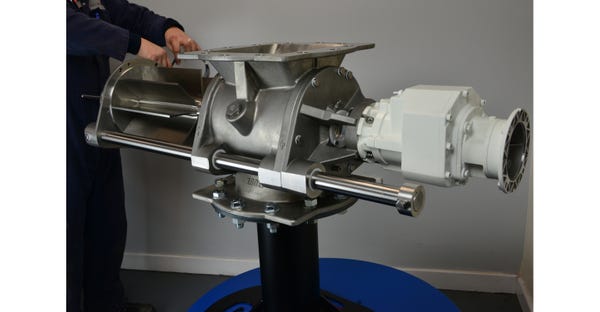
Summary
There are a wide range of rotor types, styles, and options, and it is critical that a user discusses the finer points of their application with the valve supplier to ensure optimal valve performance.
A valve supplier should have the knowledge and experience to specify the most appropriate rotor solution and not just offer the rotor that best suits from an upfront cost perspective and then later fails to provide excellent service life to the customer. The correct rotor for the application has the ability to significantly reduce the whole-life cost of a valve through savings on downtime, maintenance, and parts costs.
Kevin Steele is engineering manager, Rotolok Valves Inc. (Monroe, NC). For more information, call 704-282-4444 or visit www.rotolok.com.
You May Also Like


